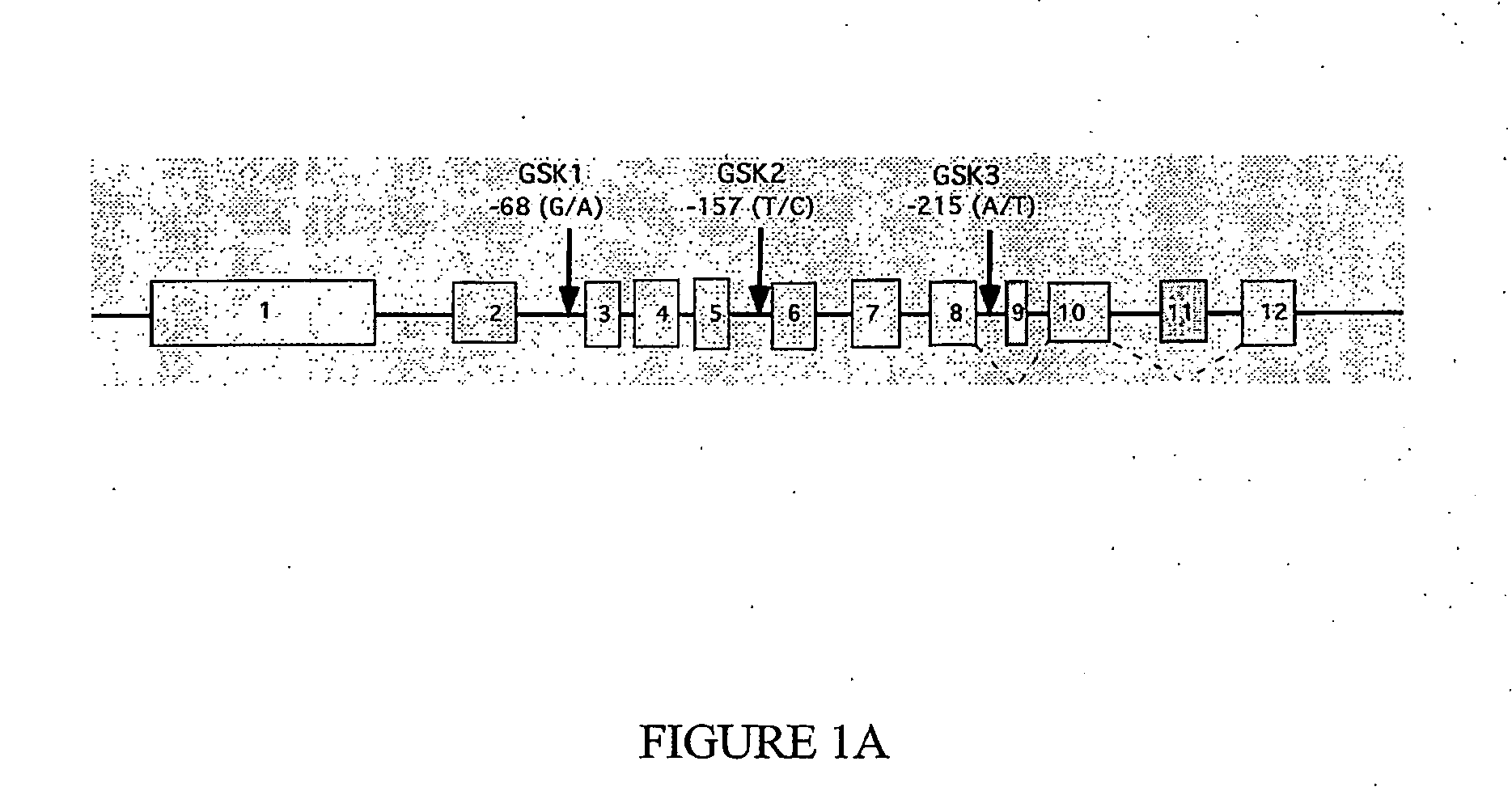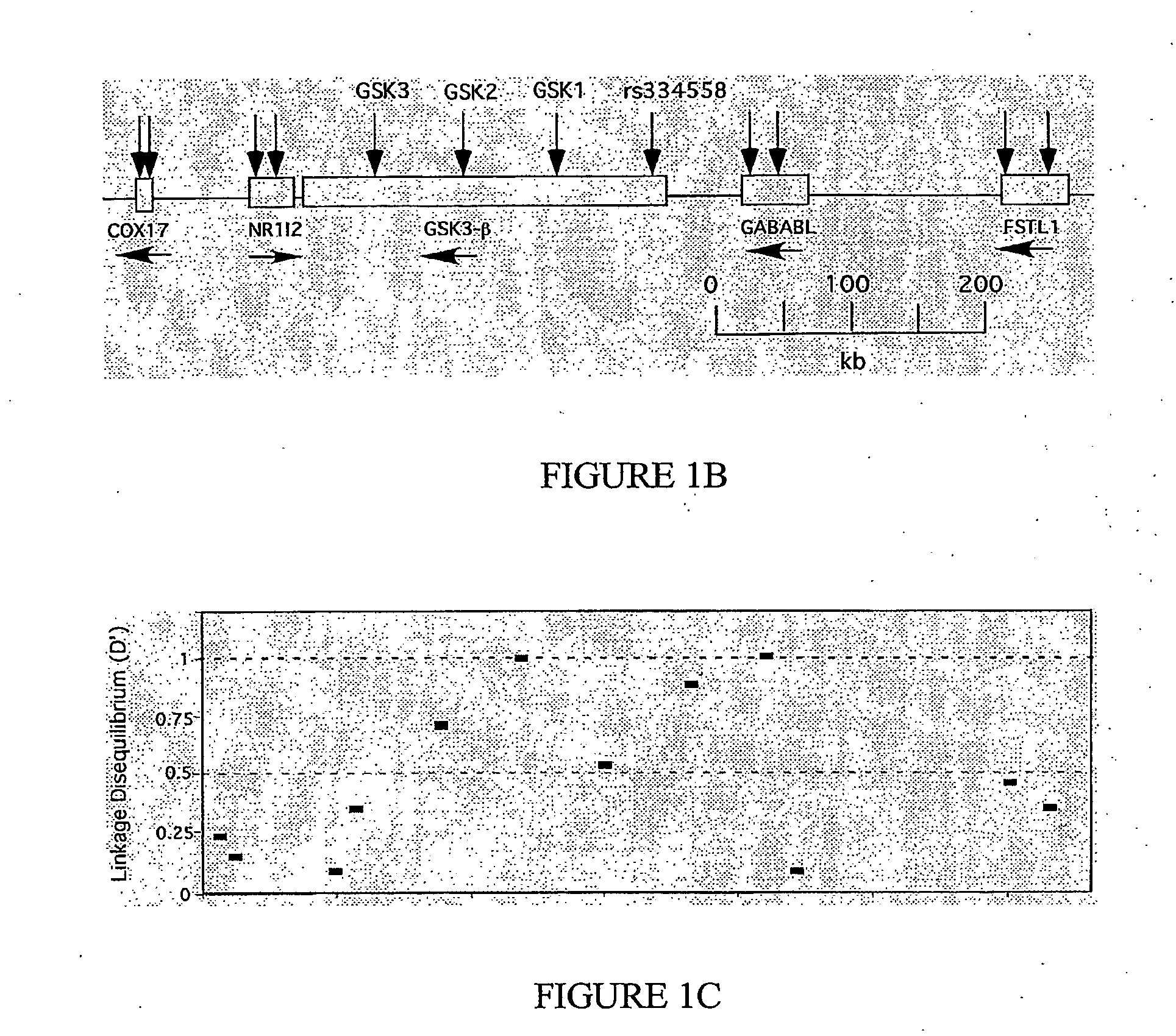Detecting disease association with aberrant glycogen synthase kinase 3beta expression
a glycogen synthase and aberrant technology, applied in the direction of biocide, sugar derivatives, plant growth regulators, etc., can solve the problem of further increase in the risk of developing neurodegenerative diseases
- Summary
- Abstract
- Description
- Claims
- Application Information
AI Technical Summary
Benefits of technology
Problems solved by technology
Method used
Image
Examples
example 1
Association of a SNP Within GSK-3β with Neurodegenerative Diseases
1.1 Samples
[0449]Clinical data and DNA samples from the UK case / control cohort were collected from 546 individuals (74% females, 26% males) with Alzheimer's disease and 546 control subjects (74% females, 26% males). Age of onset ranged from 60 to 92 years (mean=75.45 years, SD=6.485). Controls were matched for age (mean=76.30, SD=6.257), gender and ethnicity. The sample was recruited from both community and hospital settings and an assessment battery was used to form a diagnosis of probable AD according to NINCDS-ADRDA criteria (McKhann, G. et al. Neurology 34: 939-944, 1984). Controls were selected in two ways. Spouse controls were selected on the basis of the participation of their AD partner. Controls were also collected from general practices in the same areas as the AD patients. The Sydney Older Person Study (SOPS) cohort is a population-based cohort of community living elderly people (>75 years old) within a spe...
example 2
Effect of the Intron 5 SNP on Splicing of GSK-3β
[0456]Each allele from the three intronic polymorphisms described in Example 1 was subcloned in the exon trap vector pSPL3 (Invitrogen, Carlsbad, Calif., USA). For the exon 3 SNP, a 506 bp genomic fragment with 239 bp 5′ and 183 bp 3′ intronic sequences was used. For the exon 6 SNP, a 600 bp genomic fragment with 250 bp 5′ and 243 bp 3′ intronic sequences was used. For the exon 9 SNP, a 549 bp genomic fragment with 406 bp 5′ and 206 bp 3′ intronic sequences was used. Each recombinant vector was transfected into the neuroblastoma cell line, SK-N-MC (ATCC HTB 10) and embryonic kidney 293 cells (ATCC CRL 1573) using Lipofectamine 2000 (Invitrogen, Carlsbad, Calif.). Cells were left for 48 hours before total RNA was extracted and the exon trap products detected by RT-PCR essentially as described previously (Teare et al., Ann. Hum. Genet. 66: 223-233 2002).
2.2 Results
[0457]The three intronic GSK-3β SNPs described in Examp...
example 3
Analysis of Splicing of GSK-3β in Patient Samples
3.1 Analysis of GSK-3β Transcripts
[0458]Total RNA was extracted from lymphocyte cells derived from subjects homozygous for either the T or C allele at the SNP in intron 5 of GSK-3β. RNA was extracted using the SV Total RNA Isolation System (Promega). 2 μg of RNA was reverse transcribed using the Superscript II RT enzyme (GibcoBRL) and a random hexamer primer (GibcoBRL), followed by PCR amplification using the primers GSKRT-2F (5′-TGTTGGAGTTCCCAGGACCTTG-3′) (SEQ ID NO: 32) and GSKRT-R (5′-AGTAACTGGTGGTTTTTCCTGTGC-3′) (SEQ ID NO: 33).
[0459]The relative ratio of PCR products with or without exon 9 and exon 11 sequences was determined semi-quantitatively by PCR amplification essentially as described by Stanford et al., Brain, 123, 880-893, 2000) using 0.2 μg of cDNA template and 33P end-labeled GSKRT-F primer.
3.2 Western Blot Analysis of GSK-3β
[0460]Approximately 25 μg of protein lysates from lymphocytes were heated to 95° C. for 10 minut...
PUM
| Property | Measurement | Unit |
|---|---|---|
| Fraction | aaaaa | aaaaa |
| Fraction | aaaaa | aaaaa |
| Fraction | aaaaa | aaaaa |
Abstract
Description
Claims
Application Information
 Login to View More
Login to View More - R&D
- Intellectual Property
- Life Sciences
- Materials
- Tech Scout
- Unparalleled Data Quality
- Higher Quality Content
- 60% Fewer Hallucinations
Browse by: Latest US Patents, China's latest patents, Technical Efficacy Thesaurus, Application Domain, Technology Topic, Popular Technical Reports.
© 2025 PatSnap. All rights reserved.Legal|Privacy policy|Modern Slavery Act Transparency Statement|Sitemap|About US| Contact US: help@patsnap.com



